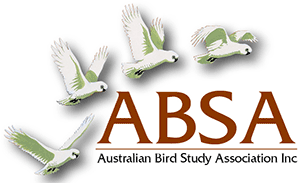Template Information
Overall aim of AACTT:
- To compile a picture of the avian populations at various sites across Australia over time.
- To present data in a standard format whereby further analyses can be utilized.
The Report will be in two parts:
- An abridged version of the findings of the study will appear in Corella. This will be listed under the name of the site and a number, similar to that used for our Seabird Island Series.
- The report, itself, will be published online at www.absa.asn.au. This will enable reproduction of large tables and bird lists, which would be impossible to include in Corella due to their size.
Banding Report Guidelines for Prospective Authors (*required information)
*Heading
Name of Site and Number (this can be obtained from the Assistant Editor).
*Aim
The specific aim for this particular project is to be outlined.
*Location
- A satellite image or aerial photograph (if available in a format that is clearly discernible) can be used with the area under study delineated. Otherwise a map is to be included.
- Latitude and longitude need to be stated.
- Altitude should be included – if there is a large variation then the range is to be stated.
- Map references (not mandatory) and the nearest town are handy to include to assist readers in easily locating the site.
*Description of site (this can be of a general nature)
This can include some or all of the items below:
Geology
- State the underlying rock type/s (e.g. sandstone, shale, granite etc.) or soil type (sand dunes, alluvium etc.)
Vegetation
Further analyses may be considering habitat types so the following are necessary so that habitats can possibly be linked.
- Listing the main tree species present at the site (if present)
- A general comment on the understory (e.g. dense or thin shrub layer, grassy areas etc)
Other items
- Is this area connected to other similar areas or are adjacent areas urban, farmland, etc.?
- Has the area changed over time (just general comments)? This could include the history of land use at the site.
- Are there any management issues that could have a bearing on the bird fauna (e.g. control burning, bulldozing firebreaks, poisoning of weeds etc.)
- Topography e.g. creeks (constant running, ephemeral), hills, etc.
*Status of Site
Whether the site is located within a National Park, Nature Reserve, local council reserve, forest reserve, private land etc.
Previous Records
Only references from published works should be used. They could include items pertaining to those listed above.
*Duration of study
The period for which data were collected is to be listed noting any missing periods.
Weather
General comments can be made here (e.g. main rainfall occurs in winter)
Rainfall and temperature patterns can be included only if they are specifically related to the study.
Other events that occurred during the study that could have affected the numbers or distribution of the avian populations can be mentioned. These may include:
- Fires (hazard reduction/wildfire)
- Floods
- Feral animals (occurrences – no control or control by baiting etc.)
- Grazing by domestic stock and watering points
- Land clearing
*Methods
- The frequency of visits needs to be stated (e.g. once a month, once per season etc.). Actual visit days (dates) can be included in the results
- The type of nets used including mesh size
- It should be stated what type of net lanes have been used (set, varied, opportunistic…)
- The banding effort should include:
- Length of nets used (total length)
- Length of time open and when (e.g. 4 hours starting at daybreak …)
- Sightings records can be included but a statement of whether they were incidental or utilising regular transects should be included. The number of observers could also be added if the data are available.
- If the study included colour banding of certain species, this can be mentioned but no analysis is needed in this Report.
*Results
These will, of course, depend on the data collected.
- Short-term studies – data can be presented per banding day
- Long-term studies – data can be presented in period groups (e.g. seasons, yearly etc….)
These data can be tabulated on an Excel spreadsheet and can go over several pages if necessary:
- Species (both common and scientific names)
- Capture Rates (calculated as the number of birds trapped per 100m of net per hour)
- Total No. Banded
- % Retrapped (see below)
A retrapped bird should only be counted once (irrespective of the number of times it was retrapped). The percentage is simply calculated by dividing the number of retrapped birds by the total number caught.
Other data that may be included:
- Longevity – only if necessary for discussion
- Movements – to or from the site
- Migrant species returns to site of banding
Any significant longevity, movement and migrant return records can be submitted for inclusion in Recovery Roundup.
- Species breeding at the site can simply be designated as such on the spreadsheet
- Species can also be listed as migrant/resident/vagrant at the site and can again be displayed on the spreadsheet.
*References
As per format in Corella.
*Acknowledgements
*Authors(s) name(s) and address(es)
